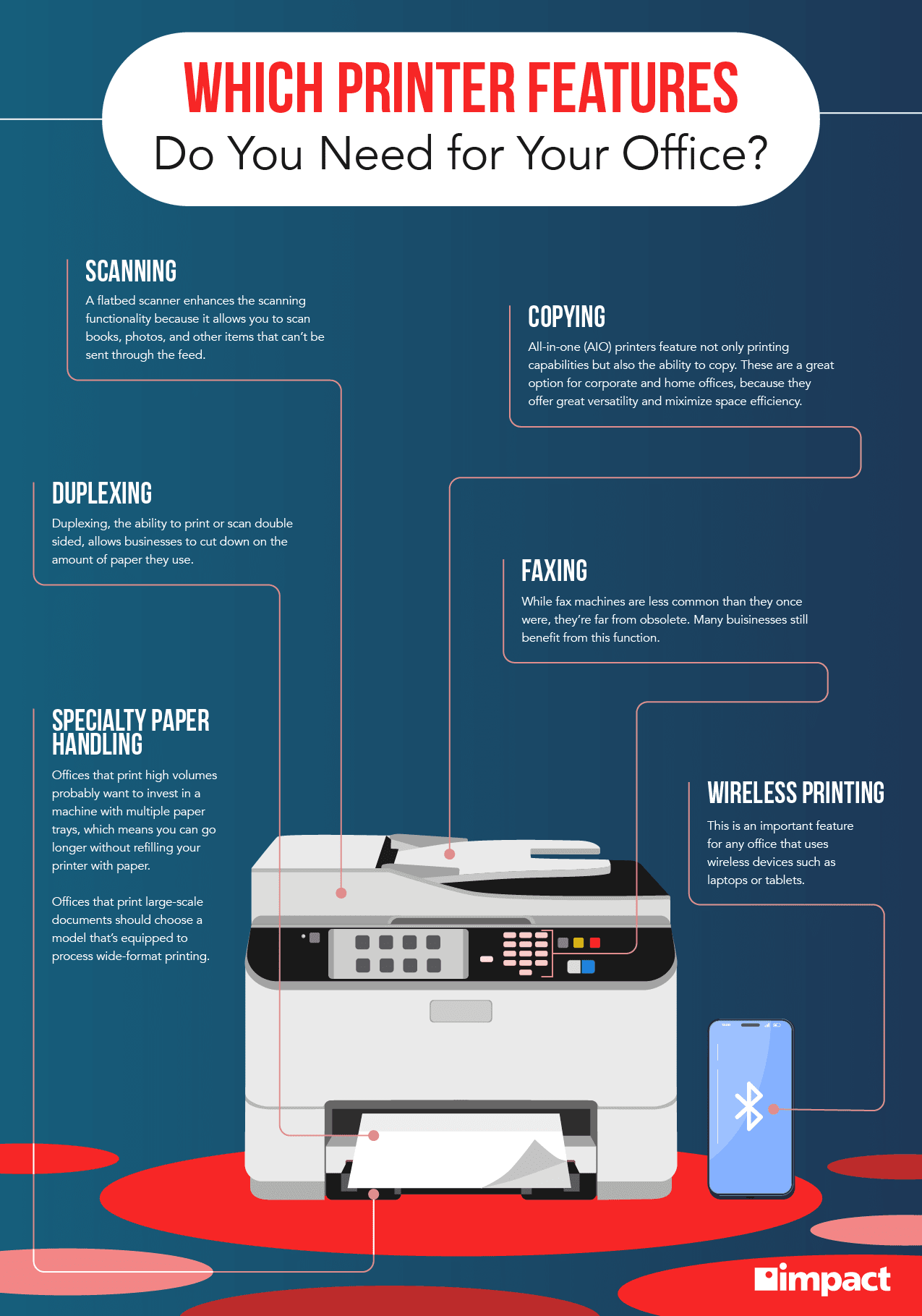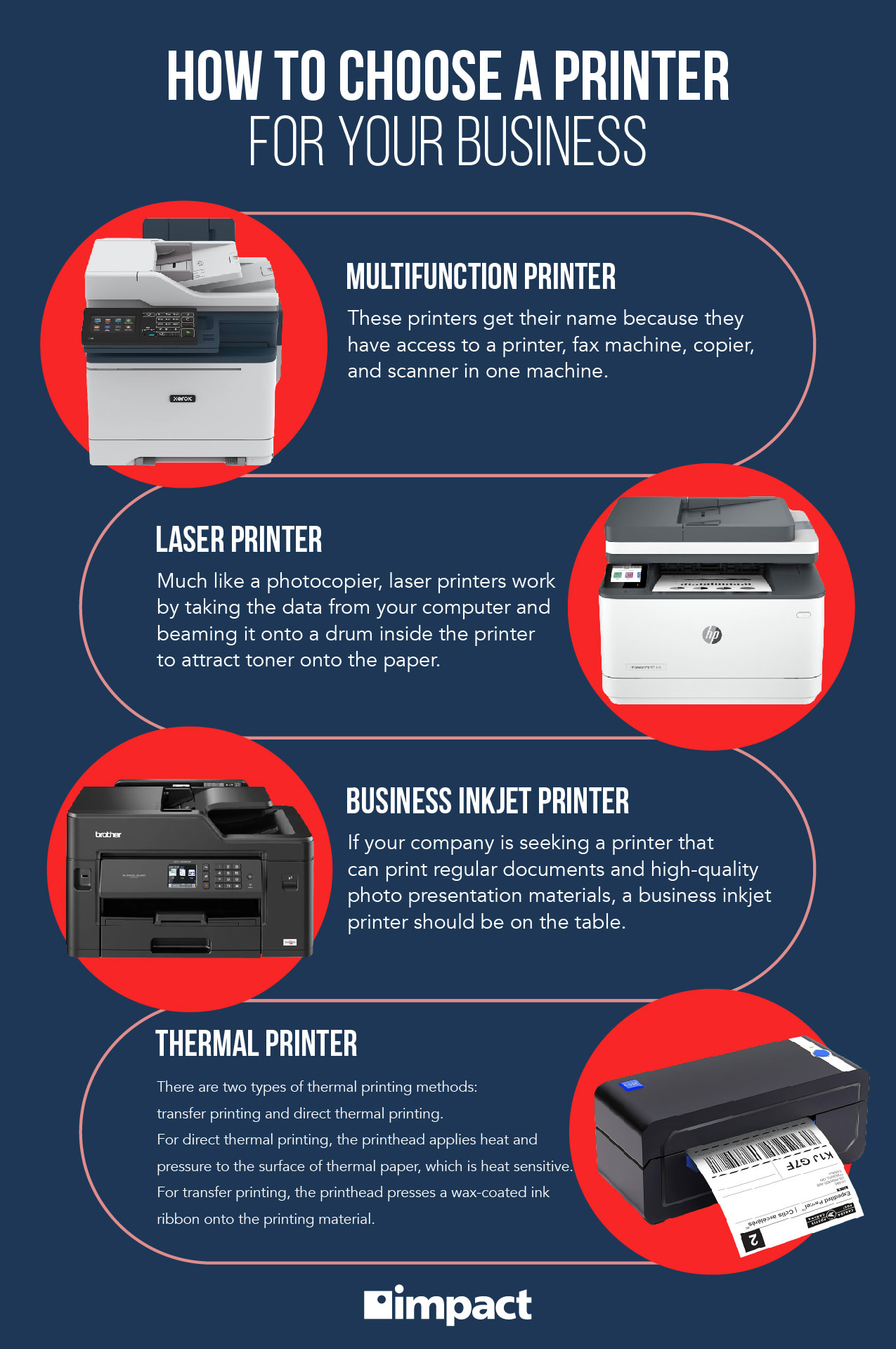Buying printers can be an important but costly purchase, so knowing which printer will be beneficial for your business is essential. Below we explain the key features to consider when choosing the best printer for your small business to save you some time and stress when making your decision.
If you’re looking to update your office equipment or restock on printing supplies, visit the Impact Store where you can browse machines, restock paper, and take care of all your printing needs.
Qualities to Consider When Picking Your Office Printer
We’ve come a long way since Gutenberg—printers today can be surprisingly complex. Here are some features to take into consideration when making your purchase:
- Upfront Cost: Ultimately, small businesses have a limited budget set aside to purchase a new printer.
- Long-Term Costs: Going with a cheaper printer may save money initially, but you must also consider long-term costs—such as cartridge replacements, maintenance, and energy consumption—since these can add up over time.
- Maintenance Requirements: Consider if your printer will require extra costs to repair or maintain.
- Printing Quality: Are you looking to use your printer for internal documents or to share critical data with prospects, clients, or other VIPs?
- Printing Speed: If you frequently print large documents, you don’t want to get bogged down by slow printing speed.
- Printing Type: Will you need your printer to create colorful images that are high quality? Or do you need a printer solely for grayscale text?
Printing costs can add up quickly, especially without data tracking. Many companies have little to no insight into how to manage paper consumption and printing costs. Hiring a managed service provider to oversee print services can be beneficial for reducing those costs.
Types of Printers
Consider the different options of printers your business may want to invest in:
- Multifunction Printers
- Laser Printers
- Inkjet Printers
- Thermal Printers
- Specialty Printers
1. Multifunction Printers
Multifunction, also known as all-in-one, printers are a cost-effective option. These printers get their name because they include a printer, fax machine, copier, and scanner in one unit.
Pros of multifunction printers:
- Cost-Effective: By purchasing a multifunction printer, you eliminate the need to buy additional hardware separately for your office. You also save money as you won’t need to buy toner for a copier and printer or ink for a fax machine.
- Space Saver: Multifunction printers combine multiple machines, freeing up space for other necessities in your office space.
- Higher Speeds: If you purchase a high-quality multifunction printer, it will have better printer and copy speeds compared to a separate copy machine and laser printer.
Cons of multifunction printers:
- Risk of Traffic Jams: If multiple people need to use a single multifunction printer at the same time for different reasons, it is inevitable that a traffic jam will occur.
- Multitasking Might not Work: Not all multifunction printers are able to execute two tasks at once, therefore leaving your company vulnerable to missing incoming faxes and other issues.
2. Laser Printers
Much like a photocopier, laser printers work by taking the data from your computer and beaming it onto a drum inside the printer to attract toner onto the paper. If your office requires a printer that can handle a heavy volume, a laser printer may be right for you.
Pros of laser printers:
- Long Lasting: Laser printers are durable and are built to last for years.
- Saves Money in the Long-Term: Upon initial purchase, the laser printer can be expensive, but this type of printer relies on laser toner cartridges, which can print many more pages than the cartridges needed for other printers.
- Reliable Printing Quality for Text: Documents containing text come out sharp.
- Quick Printing Speed: For businesses that need to print a large volume of documents, laser printers are beneficial as they can quickly pump out pages.
Cons of laser printers:
- High Initial Cost: In comparison to an inkjet printer, the upfront cost can be prohibitive.
- Poor Photo Printing Quality: If you regularly print photos, marketing materials, or other colorful and highly designed documents, this printer may not meet your needs.
- Uses Specific Paper: These printers sometimes require paper made specifically for them.
3. Inkjet Printers
If your company is seeking a printer that can print regular documents and high-quality presentation materials at a high volume, an industrial Inkjet printer should be on the table. If you aren’t expecting a high volume of print jobs, though, a consumer-grade Inkjet printer might offer all you need.
These printers tend to be attractive to small business owners looking for a printer that has a reduced long-term cost.
Pros of Inkjet printers:
- Cheaper, Refillable Cartridges: Inkjet cartridges cost less than toner cartridges. Plus, instead of having to buy new inkjet cartridges, you can refill them!
- Great for Photo and Graphic Printing: This is important for businesses that need to print images that are high quality.
- Use a Variety of Paper: Inkjet printers are able to print on a range of paper types, including inkjet paper, textured stationary, and photo paper.
Cons of Inkjet printers:
- Prints may Smudge or Fade: Since most inkjet ink is dye-based, it can be subject to fade or smudge.
- Not Good for High-Volume Printing: This type of printer is not designed to print in large volumes. You will have to restock the paper tray when printing a larger-sized project.
- Blurry Text Result: Some printers may create blurry text when using thin copy paper.
- Must Clean Cartridges: Cleaning inkjet cartridges is required often, using up ink.
4. Thermal Printers
The most popular form of thermal printing that you’re likely already familiar with is in retail receipts, but another common use for thermal printing is the creation of shipping labels. While these printers aren’t typically used to produce documents, other uses include ID badges, barcode printing, and custom sticker creation.
There are two types of thermal printing methods: transfer printing and direct thermal printing.
For direct thermal printing, the printhead applies heat and pressure to the surface of thermal paper, which is heat-sensitive. When the thermal paper reacts to the heat, it blackens to produce text or an image.
For transfer printing, the printhead presses a wax-coated ink ribbon onto the printing material. As the wax melts, the ink is exposed and transferred to the material.
Pros of thermal printers:
- Low Cost: Since they do not rely on ink, thermal printers don’t need external supplies to run.
- Fast, High-Quality Printing Results: Results are smudge-free and quick.
- Easy to Maintain: With fewer moving parts, thermal printers tend to break less and last around ten years on average.
Cons of thermal printers:
- Label Issues: Thermal-printed labels can fade over time or turn fully black when not kept in an environment at room temperature.
- Direct Thermal Printing Only Uses One Color at a Time: While this isn’t an issue for thermal transfer printers, this is something to consider when contemplating buying a direct thermal printer.
- More Expensive Parts: Overall, thermal printers cost more than an average inkjet printer. In terms of replacing individual parts of a thermal printer, they tend to be expensive.
5. Specialty Printers
In addition to the four common printer types outlined above, there are other printers that are designed for more specific and special use cases. While these printers are slightly less common in the average office or workplace, there are certain industries that heavily rely on them in daily operations.
Two such printers are wide format printers and 3D printers.
Wide Format Printers: Wide format printers, also known as large format printers, are designed to print on larger paper sizes, typically ranging from 24 inches to 100 inches in width. They are widely used in industries such as advertising, architecture, engineering, and graphic design to produce high-quality prints for banners, posters, signage, blueprints, and other large-scale projects.
These printers can handle various media types, including vinyl, canvas, and photo paper, and often feature advanced inkjet technology to deliver precise and vibrant color output. Their ability to print large graphics without compromising on detail makes them essential tools for professionals needing high-impact visual displays.
3D Printers: 3D printers create three-dimensional objects by building them layer by layer from digital models. Using materials such as plastic, resin, metal, or even biological substances, 3D printers transform virtual designs into tangible items.
This technology is used across various fields including manufacturing, healthcare, aerospace, and education, enabling rapid prototyping, custom part production, and innovative medical solutions like prosthetics and implants. The process typically involves software that slices the digital model into thin horizontal layers, which the printer then constructs sequentially.
This additive manufacturing method allows for complex geometries and customization that are often impossible with traditional manufacturing techniques.
Final Thoughts on Choosing the Best Printer for Your Small Business
Selecting the printer most suitable for your business truly depends on your business’ demands. Multifunction printers, laser printers, office inkjet printers, and thermal printers are all potentially great choices.
To figure out which would be ideal for you, make sure to weigh upfront and long-term costs, printing quality, speed, and intended use. Understanding these options helps businesses make informed choices based off of their specific needs and budget.
Visit the Impact Store to see what modern office printers can offer, start shopping for your next set of office machines, and restock your printing supplies.


